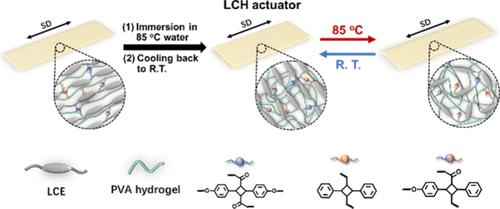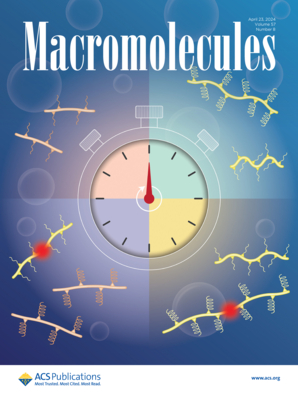在有序-无序相变过程中实现正热膨胀的液晶水凝胶致动器
IF 5.1
1区 化学
Q1 POLYMER SCIENCE
引用次数: 0
摘要
液晶弹性体(LCE)与水凝胶的结合为软致动器材料的开发开辟了一条新途径。在此,我们报告了一种新型液晶水凝胶(LCH),它由交联主链液晶聚酯作为液晶弹性体,交联聚乙烯醇(PVA)作为水凝胶组成。与现有的主链液晶弹性体致动器不同,这种致动器的特点是液晶介质相对于拉伸方向垂直排列,并且在液晶各向同性相变的拉伸方向上表现出正热膨胀。这种奇特的致动器行为源于介质的重新定向过程,即 LCH 在热水中达到热平衡并冷却后,介质从拉伸后的平行排列转为垂直排列,这似乎是由于 LCE 结构域在热松弛过程中的重新排列以及周围水凝胶结构域的各向异性膨胀造成的,因此是 LCH 致动器所独有的。水凝胶致动器的变形主要基于水扩散引起的体积变化,因此一般速度较慢,而 LCH 致动器则不同,它由介质的有序-无序相变驱动,速度更快,致动速率以秒为单位。此外,LCH 致动器不仅将 LCE 的可逆致动和 PVA 水凝胶的水控形状记忆效应结合在一起,而且还能进行光学焊接,这为致动器的设计和制造提供了便利。本文章由计算机程序翻译,如有差异,请以英文原文为准。

Liquid Crystalline Hydrogel Actuator with Positive Thermal Expansion over Order–Disorder Phase Transition
Combining a liquid crystal elastomer (LCE) and a hydrogel opens a new avenue for the development of materials for soft actuators. Herein, we report a novel liquid crystalline hydrogel (LCH) consisting of a cross-linked main-chain LC polyester as the LCE and cross-linked poly(vinyl alcohol) (PVA) as the hydrogel, whose actuator, in contrast to existing main-chain LCE actuators, features perpendicular alignment of LC mesogens with respect to the stretching direction and exhibits positive thermal expansion in the stretching direction over the LC–isotropic phase transition. This peculiar actuating behavior arises from a reorientation process of mesogens, switching from parallel alignment right after stretching to perpendicular alignment after thermal equilibrium of the LCH in hot water followed by cooling, which appears to occur due to a rearrangement of the LCE domains during the thermal relaxation as well as the anisotropic swelling of the surrounding hydrogel domains and thus is unique to the LCH actuator. Unlike the hydrogel actuator, whose deformation is mostly based on a water-diffusion-induced volume change and thus is generally slow, the LCH actuator is driven by the order–disorder phase transition of mesogens and is much faster, with an actuation rate in seconds. Moreover, the LCH actuator not only brings together the reversible actuation of the LCE and the water-controlled shape memory effect of the PVA hydrogel but also is capable of optical welding, which facilitates the actuator design and fabrication.
求助全文
通过发布文献求助,成功后即可免费获取论文全文。
去求助
来源期刊

Macromolecules
工程技术-高分子科学
CiteScore
9.30
自引率
16.40%
发文量
942
审稿时长
2 months
期刊介绍:
Macromolecules publishes original, fundamental, and impactful research on all aspects of polymer science. Topics of interest include synthesis (e.g., controlled polymerizations, polymerization catalysis, post polymerization modification, new monomer structures and polymer architectures, and polymerization mechanisms/kinetics analysis); phase behavior, thermodynamics, dynamic, and ordering/disordering phenomena (e.g., self-assembly, gelation, crystallization, solution/melt/solid-state characteristics); structure and properties (e.g., mechanical and rheological properties, surface/interfacial characteristics, electronic and transport properties); new state of the art characterization (e.g., spectroscopy, scattering, microscopy, rheology), simulation (e.g., Monte Carlo, molecular dynamics, multi-scale/coarse-grained modeling), and theoretical methods. Renewable/sustainable polymers, polymer networks, responsive polymers, electro-, magneto- and opto-active macromolecules, inorganic polymers, charge-transporting polymers (ion-containing, semiconducting, and conducting), nanostructured polymers, and polymer composites are also of interest. Typical papers published in Macromolecules showcase important and innovative concepts, experimental methods/observations, and theoretical/computational approaches that demonstrate a fundamental advance in the understanding of polymers.
 求助内容:
求助内容: 应助结果提醒方式:
应助结果提醒方式:


